Lesbian Art History in Europe 1950-2000
by Birthe Havmøller, editor of Femininemoments.dk
This article is based on facts and pieces of lesbian and queer feminist art news from Northern Europe that have come my way during the 20 years that I have edited my resource site and art blog Feminine Moments – Queer Feminist Art Worldwide. This article is a continuation of my article, Lesbian Art History in Europe 1850 – 1950.
Introduction
The landmark 2017 exhibition, QUEER BRITISH ART 1861–1967 at Tate Britain, in London, was the first exhibition that explicitly told the story of the gay/lesbian lifestyles of the artists. The exhibition had a short biography of the artist hanging on the wall next to each work in the show.
In 2021, Queer British Art, a research group established by the Walker Art Gallery, National Museums Liverpool, UK published a list of LGBT and Queer Art group exhibitions in the UK from 1980-2000. However, they have not yet (August 2023) published a list about the 1960s and 1970s.
It was very controversial to be a lesbian in the 1950s and 1960s. Works by women artists were deliberately under-represented by the museums as in these works were not “real art” in the sense of the works being objects of value that were considered a good investment by the art museums. The individual lesbian artists and their oeuvre went below the radar of art historians in the 20th century. Today, things are slowly changing. The museums are aware of the fact that their collections must be broader and they have started curating ‘feminist art’ and ‘queer art’.
The 1950s and the 1960s were a closeted period for many lesbian artists. Homosexuality was still criminalized in many European countries – or legally taken from being a male ‘criminal offense’ and turned into a ‘psychiatric disorder’, pathologizing homosexuality in the European countries that were the first to decriminalize (male) homosexuality so that the total load of shame and blame remained the same for both sexes.
Italy decriminalized male homosexuality in 1890, Poland in 1932 and Denmark in 1933, followed by Switzerland in 1940-42 and Sweden in 1944. East Germany in 1967, The UK’s semi-decriminalization in 1967 of England and Wales, West Germany in 1968 and France in 1980… Unfortunately, it is still considered a ‘mental disorder’ in Eastern Europe.
Female homosexuality was something not to be mentioned in relation to an artist’s professional life in the 20th century. Many hidden stories may sit in archive boxes, ready for art historians to explore, once the embargo has been lifted and the artists’ personal writings may be published.
The LGBT movement in Europe started long before Stonewall. What happened in the 1970s was the splitting up of the movements into gay male organisations and lesbian organisations. The 1970s was an age of change, a paradigm shift for homosexuals. The lesbians battled for their place in the feminist movement, as the straight feminists were concerned that the presence of “mannish” or “man-hating” lesbians would hinder the cause. The self-awareness among lesbian feminists rose tremendously, and imagery with lesbian themes, especially photography, began to bloom in the 1980s.
The photographers developed a new ‘lesbian gaze’. They questioned the heteronormative male-dominated culture by creating their own visual language with a lesbian sensibility. However, defining ‘lesbian photography’ proved to be difficult. The curators of the landmark British lesbian photography exhibition, and book of the same title, ‘Stolen Glances’ wrote in 1988:
‘There is no way to define a photograph. It is unclear whether its status depends on the photographer, the subject matter depicted, the audience of the photograph or the context in which it appears. And it is open to discussion whether an image has to satisfy all of these categories or only one of them.’
In the 1980s, along with the emerging focus on feminism in the art world, the old self-portraits and photographs of gender experiments by lesbian couples such as Claude Cahun & Marcel Moor (France/Jersey) and Bolette Berg & Marie Høeg (Norway) were (re)discovered. However, the art history of the European lesbian, bisexual and queer women artists of the 20th century is yet to be written.
A decade later the ‘queer art’ movement which originated in the USA had come to Europe to stay. The Queer Theory had caught on in academia. We saw a certain carry-over from the academic field of queer theory to contemporary art manifesting itself in the shift of vocabulary from ‘gay art’ and ‘lesbian art’ to ‘queer art’ in 1998 with the Dutch exhibition From the Corner of the Eye by the Stedelijk Museum, running alongside the Gay Games in Amsterdam, and the EuroPride art exhibitions: Ecce Homo by photographer Elisabeth Ohlson and the queer art group exhibition Elbowroom (curated by Maria Friberg and Monica Larsen Dennis) in Stockholm. The term ‘queer’ was being appropriated by the art world in Europe. The introduction to the book “From the Corner of the Eye” (1998) quotes Steven Seidelman’s 1997 definition:
‘‘Queer’ is the term for a ‘post-identity’ that positions itself against the heterosexual and homosexual mainstream. Queers want to create a culture that values ’difference’: different voices, changing identities, hybrid subjects’.
Today, ‘queer’ is both a self-chosen political and personal stance deriving from a critical suspicion of normativity and of assimilations into it, and a polite umbrella term for lesbian, gay, and/or bisexual. The artist’s queer lifestyle is perhaps not as blurred as some of them may want it to be, but their works are so much more than a mirror of the artist’s sexuality and lifestyle. The personal is always political to women artists in a male-dominated world.
Cheers to the brave lesbians who dared to stand out as out and proud artists in the 20th century!
Lesbian Art in Europe 1950-2000
As an editor and arts writer, I am faced with the problem of language barriers in Europe, adding a second layer to the hidden story of the lesbian feminist artists in Europe that have been left out of art history. I realise the limits of my language skills. Europe has 150-200 individual languages; there are 24 official languages in the EU. The top five most spoken European languages are 1 Russian, 2 German, 3 French, 4 English and 5 Turkish. Danish is my native language, and English is my second language. This article is “biased” in that it only features artists based in northwestern Europe. The cultural areas that I am most familiar with are: Scandinavia, Germany, the Nederlands, Belgium, France and the UK. I apologize for my lack of knowledge of lesbian and queer women visual artists in Southern Europe and Eastern Europe.

Finish artist duo Tuulikki Peitilaa (1958) and Tove Jansson (1956).
1950s + 1960s: Graphic Art and Children’s Books
Ida Helmi Tuulikki Pietilä (1917-2009)
was an American-born Finnish graphic artist and professor. Tuulikki Peitilä is considered one of Finland’s most influential graphic artists, with her work being shown in multiple art exhibitions. She worked as a teacher at the Academy of Fine Arts, Helsinki, and later trained graphic artists and wrote multiple books about graphic arts. She launched her creative career in the mid-1930s, she studied art, drawing and printmaking in Stockholm and in Paris. During her studies, she met the artist Tove Jansson (1914-2001) who became her lifelong partner in 1956. Tuulikki and Tove collaborated as an artist duo on many projects, including many related to Tove’s characters: the Moomin.
Tove Jansson (1914-2001)
a Finish artist, illustrator and author of children’s books. She is life-long partner of graphics artist Tuulikki Pietilä. Tove Jansson is the famous creator of the Moomin. In all, she published 13 Moomin books. Tove Jansson was not only an author and illustrator but also a painter, cartoonist and comic strip artist. In addition to authoring Moomin books, she also published novels and collections of short stories. She painted a number of renowned murals and also illustrated stories by other writers. During the 1950s, she featured the Moomin characters not only in her novels but also in her murals, picture books and comic strips. A rare collection of Moomin art was donated to Tampere Art Museum in 1986 by Tove Jansson and her partner graphic artist Tuulikki Pietilä.
In 2017 a new museum was inaugurated in Tampere, Finland. It houses the Tove Jansson collection – the world’s one and only Moomin Museum.
1950s + 1960s: (Queer) Abstraction and Abstract Expressionism
Abstract expressionism had an important queer element to it long before the term Queer Abstraction was coined. ‘Queer Abstraction’ is an American term that unites contemporary artists who utilize the possibilities of abstraction to convey what it means to exist on the margins as there is a queerness that comes through works that aren’t overtly queer.
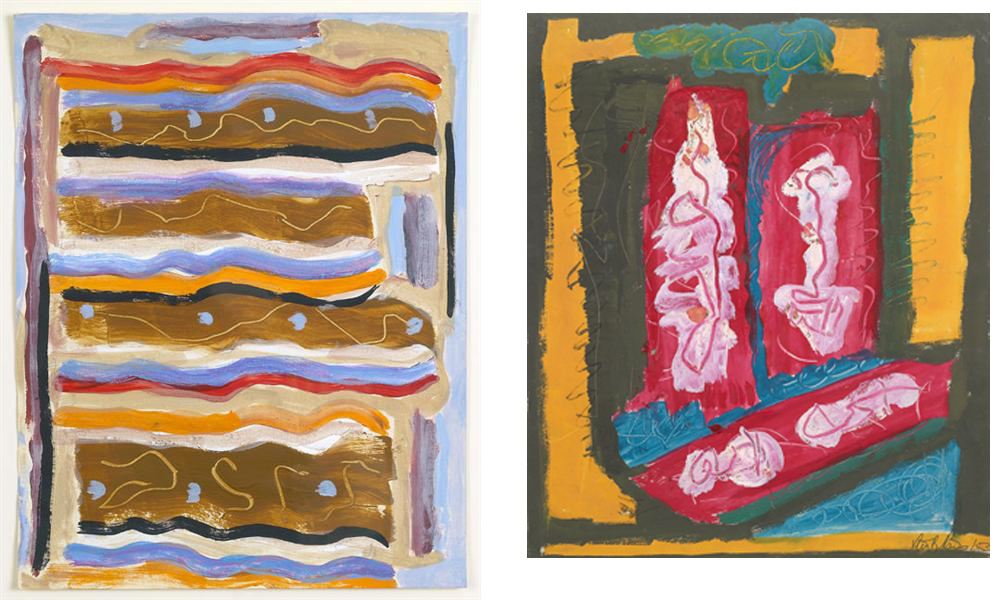
Untitled (1950) and Untitled (1953) by Betty Parsons.
Betty Parsons (born Betty Bierne Pierson, 1900–1982)
deserves a special mention. She was an American artist, art dealer, gallerist and collector known for her early promotion of Abstract Expressionism who came to Paris with her gay husband ca. 1920; they divorced three years later. Betty remained in Paris where she lived with her girlfriend, art student Anglo-Irish painter Adge Baker, for eight years. When they split up she returned to New York. Betty had her first solo exhibition in New York at Midtown Gallery (1936). A few years later she launched her career as art dealer and The Betty Parsons Gallery opened in 1946 in Manhattan. She ran her gallery until her death and is known for promoting many LGBT artists. In the 1950s she presented among others Swiss-born artist Sonia Sekula (1918-1963), painter Agnes Martin (1912-2004), and several important gay male artists including Robert Rauchenberg and Jasper John. During her lifetime, Betty Parsons received important solo exhibitions in Europe at the Whitechapel Gallery, London (1968), and Nigel Greenwood Gallery, London (1980). Her friend of many years, painter Lee Hall wrote Betty Parsons’ biography. Betty, an open lesbian in the 1920s and 1930s had, throughout the following decades of vilification of homosexuality, been quiet about her lesbianism in the 1950s and 1960s. But in the late 1970s, she told her biographer about her romantic relationships.
Betty Parsons and her generation of lesbian artists were born around 1900. Many of them gravitated to Paris or Berlin in the 1920s. But today, their later works from the 1960s and 1970s have often been forgotten or not discussed from a lesbian or feminist point of view.
Hannah Höch (1889-1978)
a German artist and bisexual woman known for her visionary DADA collages and her surrealist paintings in Weimar Germany; she spent the years of the Third Reich in Berlin, keeping a low profile. Though her work, deemed “degenerate art” by the Third Reich, was not acclaimed after the 2nd World War as it had been before during the Weimar Germany in the roaring 1920s, she continued to produce her photomontages and exhibit them internationally until her death in 1978 in Berlin.
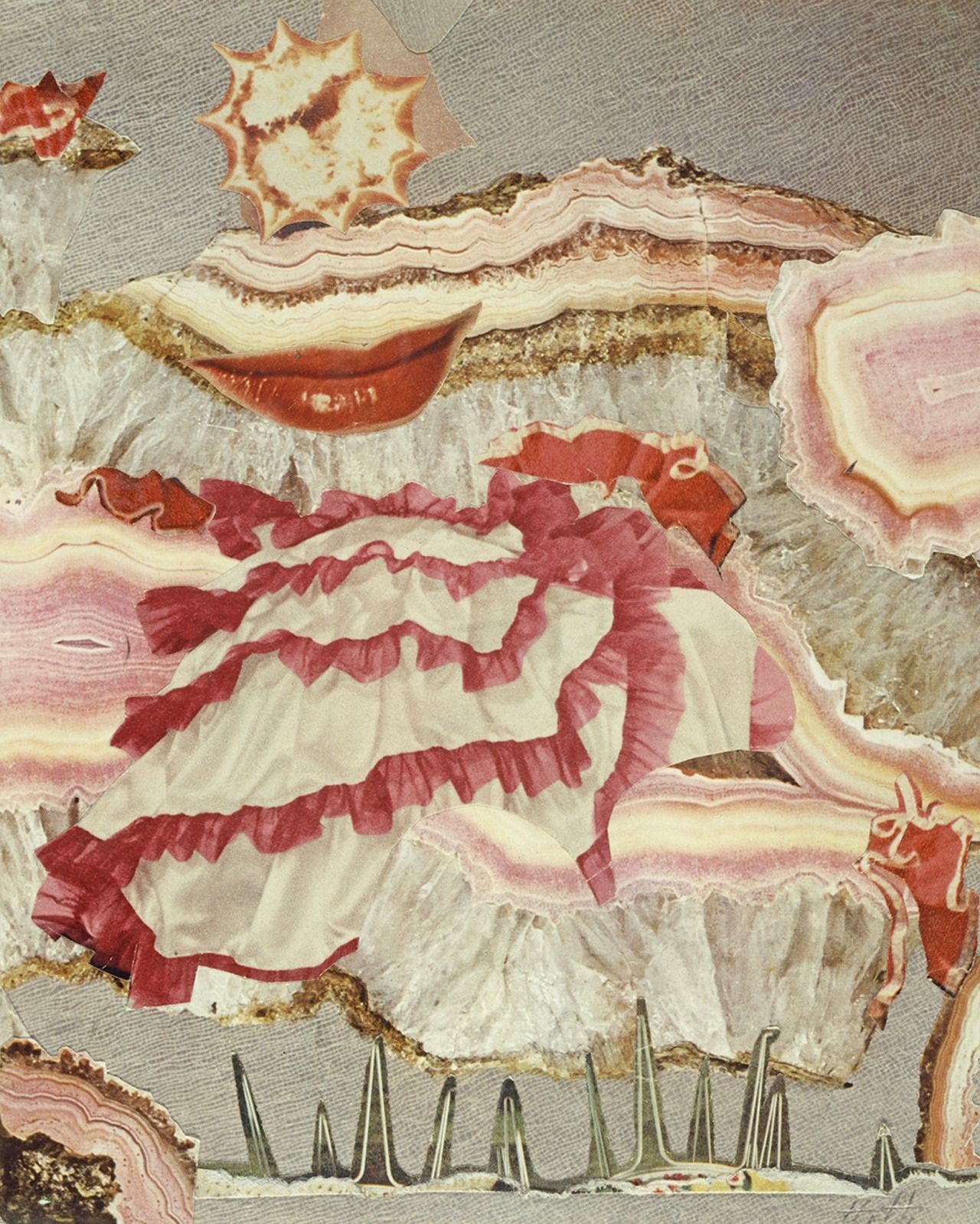
Around a Red Mouth (1967) by Hanna Höch.
Jeanne Mammen (1890–1976)
famous for her portraits of lesbians in Weimar Berlin. Following Mammen’s inclusion in an exhibition of female artists in Berlin, in 1933, the Nazi authorities denounced her motifs and subjects as “Jewish”, and banned her lithographs for the erotic poem Les Chansons de Bilitis. The Nazis were also opposed to her blatant disregard for the ‘appropriate’ female submissiveness in her expressions of her subjects. In the 1930s the Nazis shut down most of the journals she had worked for, and she refused to work for those that complied with their cultural policies. This stopped her from publishing and exhibiting her work, but it did not mean the end of her artmaking. In the late 1940s, she began exhibiting her work again, by then her work had become abstract. In the 1950s she adopted a new style, combining thick layers of oil paint with a few fine marks on the surface. Her first retrospective exhibition opened a year before her death.
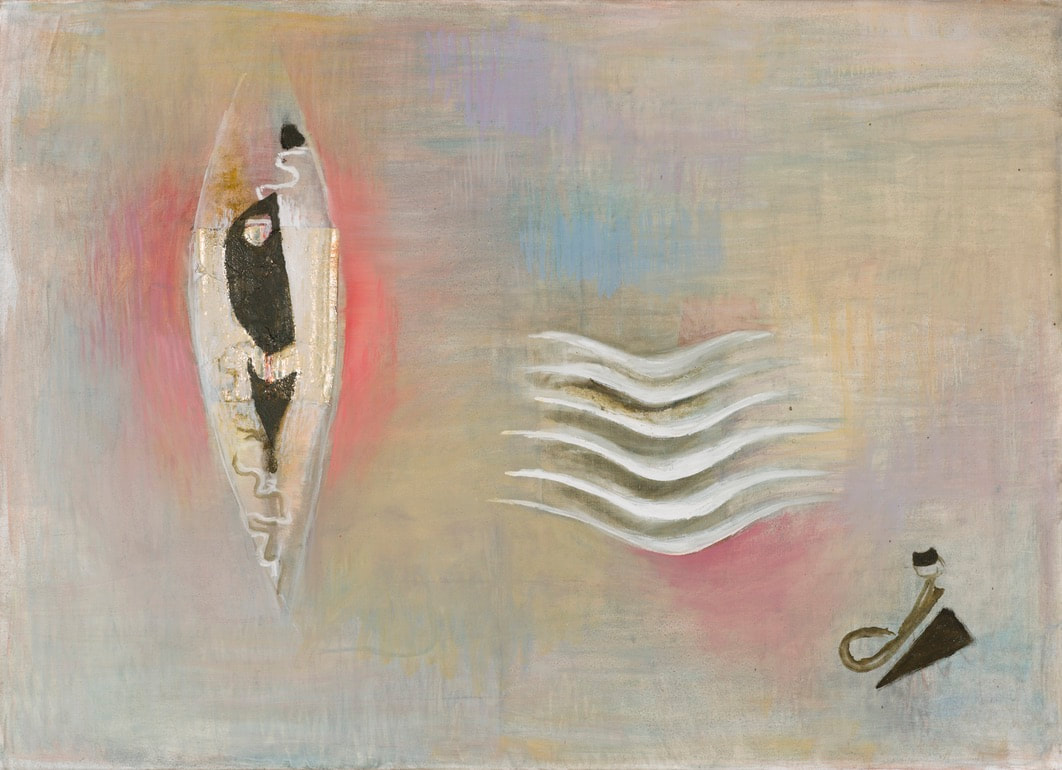
Contemplation (1960-1965) by Jeanne Mammen. Courtesy of VG Bild-Kunst, Bonn. Photo by Mathias Schorman.
In 2017–18, the Berlinische Galerie mounted a new retrospective exhibition of Jeanne Mammen’s work, titled, “Jeanne Mammen: Die Beobachterin: Retrospektive 1910–1975” (Jeanne Mammen: The Observer: Retrospective 1910–1975), that included more than 170 works in 9 various media, covering the period from the 1920s to her late work in the 1960s and beyond.
1960s: The Figurative Painters
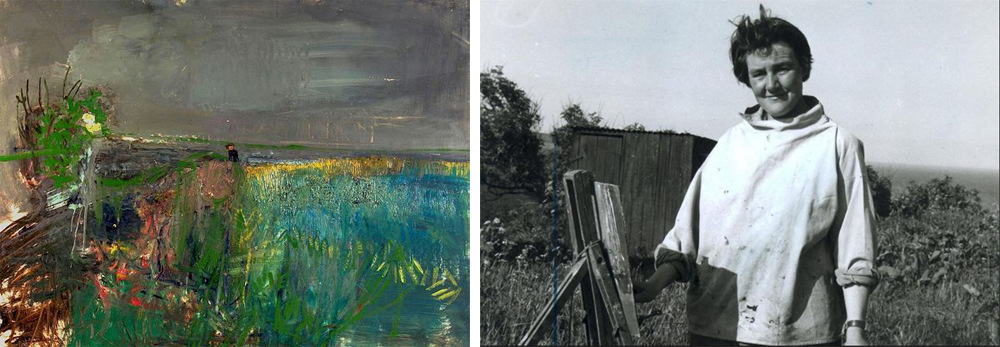
Figure in a field, Catterline (Oil, soil and sand on board ca. 1960) by Joan Eardley, and a portrait of the artist.
Joan Eardley (1921-1963)
was one of the most original and admired British artists of her generation. A painter’s painter, who created a unique visual language. Her raw, yet tender, depictions of children in 1950s Glasgow contrast vividly with her loose and expressive landscapes painted around Catterline in the northeast of Scotland. Joan Eardly had a long-term relationship with a married woman, the photographer Audrey Walker.
Joan died at the age of 42 in 1963. In 2013, a collection of letters written by Joan Eardley to Audrey Walker was released, having been placed under an embargo by Audrey until decades after her death.
Leonor Fini (1907-1996)
was an Argentine-born Italian artist and bisexual woman. She is often called a ‘surrealist’, however, she never considered herself to be a part of the French surrealists though she knew them well and exhibited with them. Her painting of women making love in a train, “Le Long du Chemin” (1966) is one of her most widely known “lesbian” images. A predominant theme of Leonor Fini’s art is the complex relationship between the sexes, primarily the interplay between the dominant female and the passive, androgynous male. A lesser-known facet of her work is that of an artist very attached to the use of paper, painting watercolors and making book illustrations. She produced illustrations for The Tempest by Shakespeare, 1965, and for the Complete Imaginative and Poetic Works of Edgar Allan Poe, 1966. Leonor Fini illustrated nearly fifty books.
In 1986, the Musée du Luxembourg in Paris presented a retrospective of Leonor Fini’s works featuring 260+ works including watercolors and drawings, theatre/costume designs, paintings and masks.
Ulrike Ottinger (born in 1942)
is a German filmmaker, photographer and visual artist. From 1962-1969, she lived as an artist and openly lesbian in Paris, working on the “nouvelle figuration” (the new figurative) paintings/pop art. Upon returning to Germany in 1969 and moving to Berlin in 1973, she started perusing her career as a filmmaker. Ulrike is known for her avant-garde, carnivalesque works of queer radicalism, creating both fiction films and documentaries. As an avant-garde filmmaker, she is one of the amazing lesbians in Europe who laid the heritage for Queer Cinema, along with Belgian director Chantal Akerman (1950-2015) and African Indian, filmmaker Pratibha Parmar who is living in the UK.
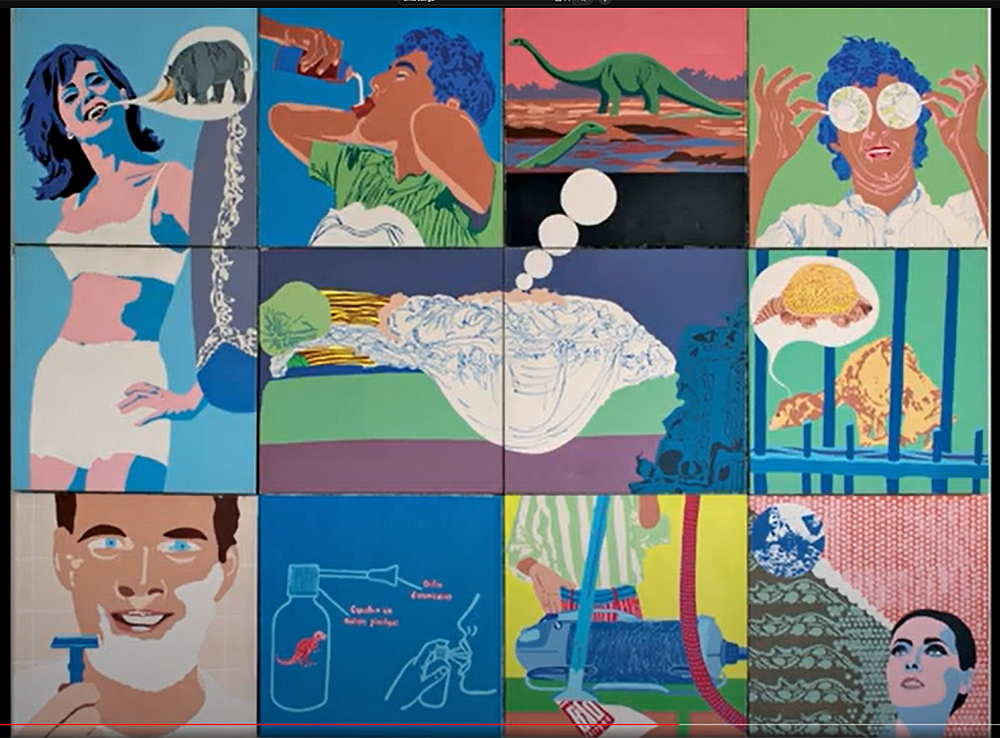
A pop artwork by Ulrike Öttinger from the late 1960s. The image is a ‘fair use image’ from the trailer of the documentary, Paris Caligramme (2020) by Ulrike Öttinger.
Some of Ulrike’s pop art paintings can be seen in a trailer about her recent self-biographical feature-length film ‘Paris Calligrammes’ (2020), a self-biographical avant-garde documentary about her life in Paris in the 1960s.
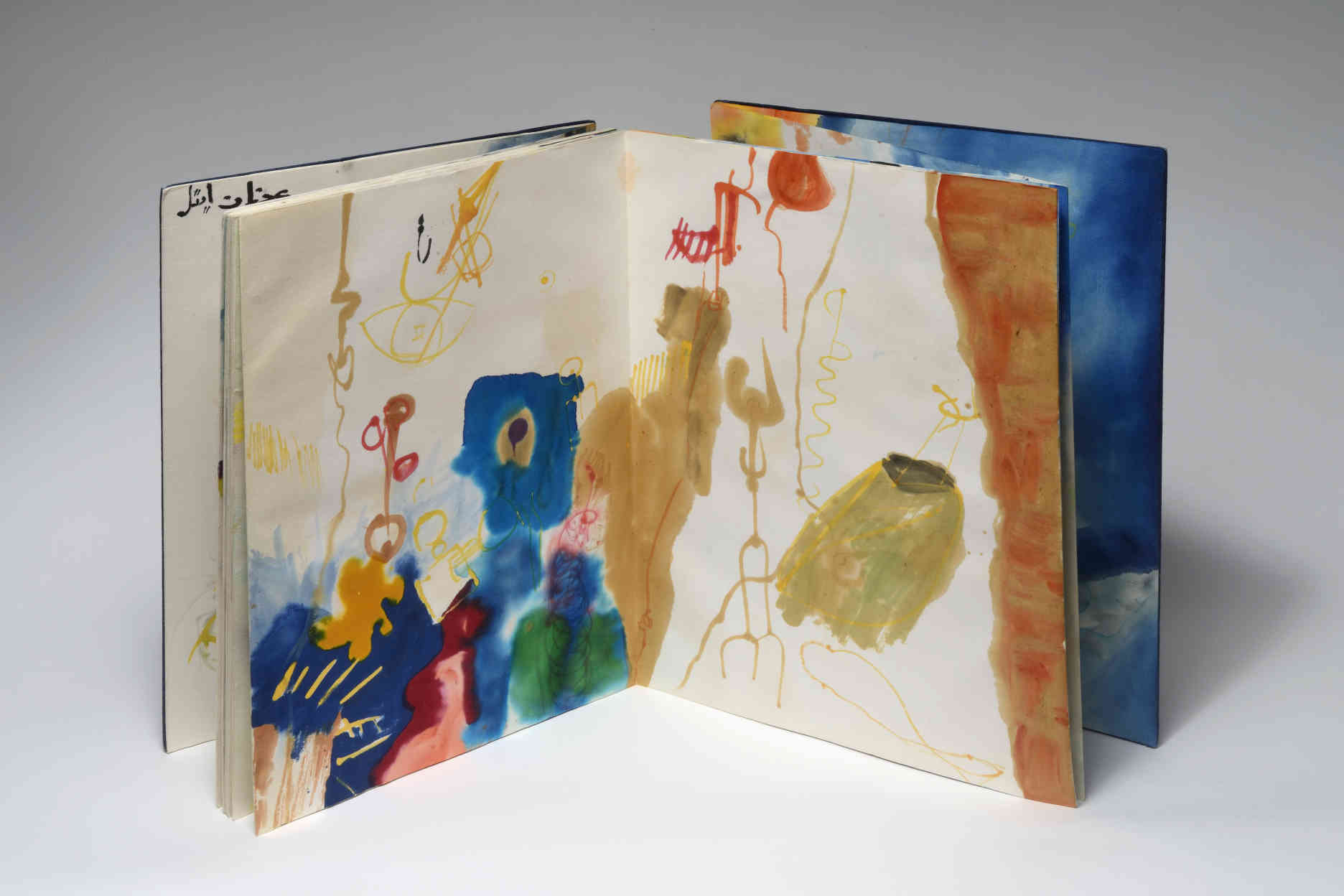
Badr Shaker Al-Sayab, la Mère et la Fille perdu (1970). Artist’s book, watercolor on paper by Etel Adnan.
Etel Adnan (1925-2021)
was a Lebanese-born American painter, poet and essayist. She is known for her abstract landscape paintings and her distinct use of color. From 1958 to 1972, she taught philosophy at Dominican College of San Rafael, California. In the 1960s, she began integrating Arabic calligraphy into her artworks and Artist’s Books and her creative expression shifted to visual art. In her later years, Adnan began to openly identify as lesbian. Etel Adnan and her partner lived in France and California until her death in 2021.
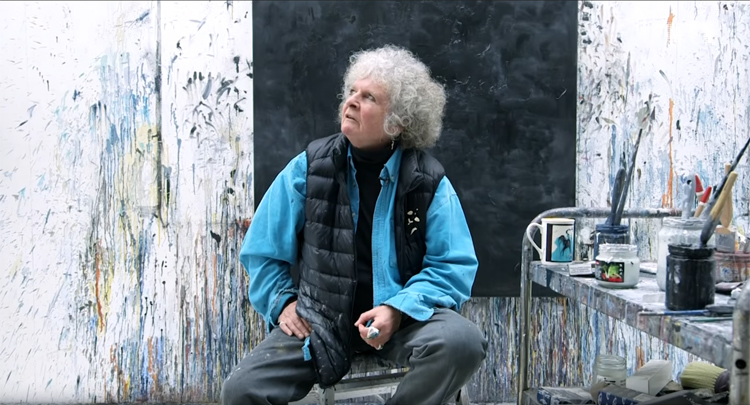
Maggi Hambling, 2019.
Maggi Hambling (1945)
is a British painter, sculptor and self-identified as queer woman. She is known for her expressive portraits and sublime depictions of landscapes and seascapes. After a four-year period of performance and installation art, Maggi Hambling returned to painting in 1973 where she painted four portraits of Frances Rose, the artist’s neighbor in Clapham, London, a retired working-class woman. In 1980, Maggi became the first Artist in Residence at the National Gallery in London. Maggi and artist Victoria ‘Tory’ Dennistoun (1938) started their relationship in 1983. They live in England.
Maggi Hambling’s best-known public works are the sculptures A Conversation with Oscar Wilde (1998) and A Sculpture for Mary Wollstonecraft (2018) in London, and the 4-metre-high steel Scallop (2003) on Aldeburgh Beach.
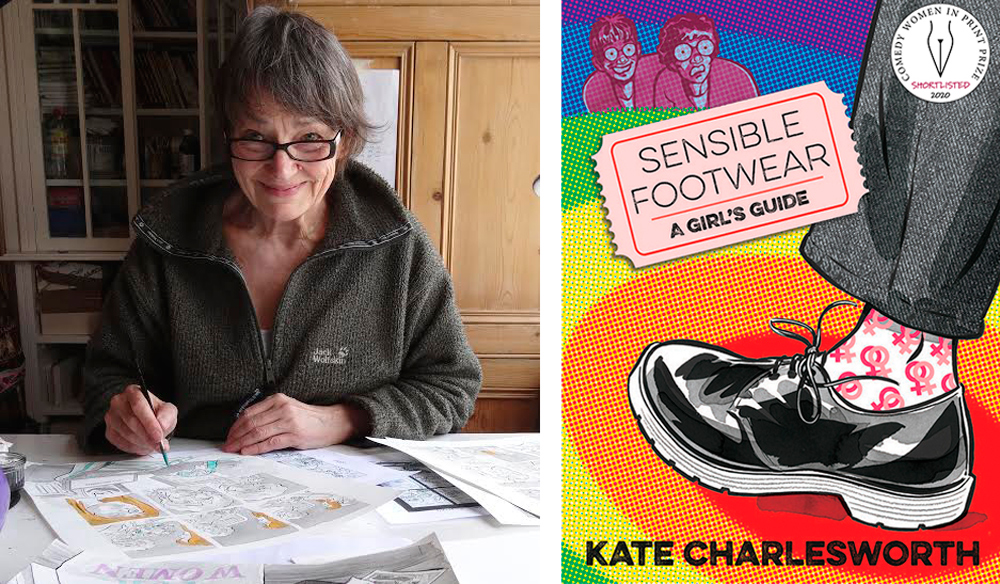
Kate Charlesworth and the cover of Sensible Footwear.
Kate Charlesworth (1950)
is a British cartoonist and self-identified as dyke artist who has produced comics and illustrations since the 1970s. Her work has appeared in LGBT publications such as The Pink Paper, Gay News, Strip AIDS, Dyke’s Delight, and AARGH, as well as The Guardian, The Independent, and New Internationalist. She currently lives with Dianne, her partner of 13 years, in Scotland.
Kate Charlesworth’s latest book, Sensible Footwear (2019), part memoir, part social history, her book is a personal history of British LGBTQ life that begins postwar and ends in the present day.
1970s + 1980s: The New Lesbian Gaze
Does a female gaze have a different sensibility to a male gaze? Is it less violent, less predatory? The traditional ‘male gaze’, looking at the world through the eyes of a white male artist, was questioned and inverted by early lesbian feminist photographers in the 1970s. They felt a lack of representation in the arts and the media and acted on their need to see themselves represented by photographing themselves and their close friends. Their work with the ‘Lesbian Gaze’ and the new lesbian photography resulted in a huge body of photos of lesbians by lesbians for women to enjoy. Their effort to portray themselves and the 2nd wave of lesbian feminists is important in a historical sense: They made documentary photos of lesbians and other women from their communities protesting or engaging in other activist activities – real images of LGBTQ+ daily life and activism(!) as well as sensual artworks.
John Berger’s BBC series ‘Ways of Seeing’ (1972) has had a lasting influence, and in particular because he introduced the concept of the ‘male gaze’, as part of his analysis of the treatment of the (female) nude in European painting.
Ruth Bernhard (1905-2006)
Ruth Bernhard deserves a special mention, because she embodied the archetype of the woman-identified photographer, long before the lesbian movement emerged in the 1960s. However, she was unfortunately not to serve as a role model for the younger photographers as the 1950s and 1960s were a closeted time.
Ruth was a German-born American photographer best known for her studio-based practice of photographing nudes. After studying for two years at the Berlin Academy of Art, she moved to New York in 1927. By her late 20s, she was deeply involved with the lesbian subculture of the artistic community of Manhattan, and in 1934 she began to photograph nude women, which would become her best-known subject. By 1944 she had met and became involved with artist and designer Eveline (Evelyn) Phimister. The two moved in together and remained together for the next ten years in California. Two Forms (1962), one of Ruth Bernhard’s most famous images, features a real-life interracial lesbian couple in a passionate embrace. In that work, a black woman and a white woman who were real-life lovers are featured with their nude bodies pressed against one another.
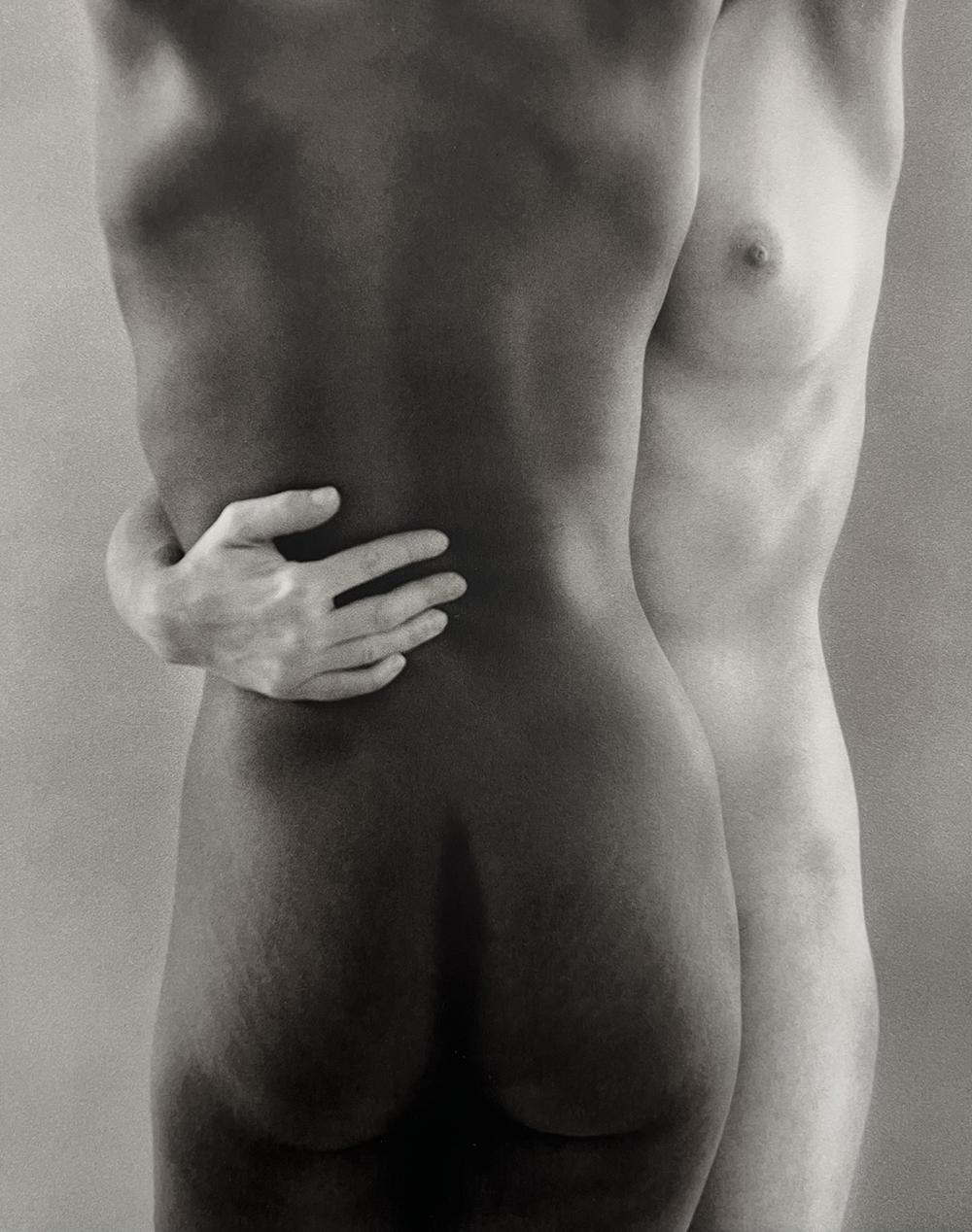
Two Forms (1962) by Ruth Bernhard.
An autobiographic film entitled Illuminations: Ruth Bernhard, Photographer, premiered in 1989 and the 1990s, in her 90s, Bernhard cooperated with biographer Margaretta K. Mitchell in the book Ruth Bernhard, Between Art and Life (2000), publicly revealing her many affairs with women and men throughout her lifetime. Ruth Bernhard had a long successful professional career, she lived to be 101 years old.
The Lesbian Gaze
The new lesbian gaze on women by women was a manifestation of both documentary photographs for magazines and artworks for exhibitions in the US and in Europe. The imagery featured women of all ages, genders, sexualities, ethnic groups and body-types.
Gon Buurman (1939-2023)
was among the first Dutch lesbian photographers in the early years of the women’s art movement. Together with photographers, Diana Blok, Marlo Broekmans and Marian Bakker, she became one of the pioneers of lesbian visibility in the Netherlands. She has produced several documentary photography books among these are: ‘Aan hartstocht geen gebrek (De Brink, 1991) /Passion in Plentitude: Handicap, Body Image and the Erotic (Ploegsma/De Brink, 1991) about sexuality and passion of physically handicapped people.
Ditte Wessels (1937)
studied in 1989 at the Hogeschool voor de Kunsten in Arnhem, Netherlands. The central theme of her creative practice is an exploration of her own identity as a lesbian. Questions like: ‘To what extent is there a lesbian identity?’ and ‘Is there such a thing as Lesbian Art?’ play an important role in her photography and self-portraits. She makes masked but also vulnerable self-portraits. Ditte has mainly exhibited her works in gay and lesbian circles, her works were included in the traveling photography exhibition “Lesbian ConneXion/s” (1998). She has also exhibited her works together with her partner, Marian Bakker, at Lesbenwoche in Berlin (1990), at the Silberblick Gallery in Berlin (1995) and at the Artemys Gallery in Bruxelles (1999).
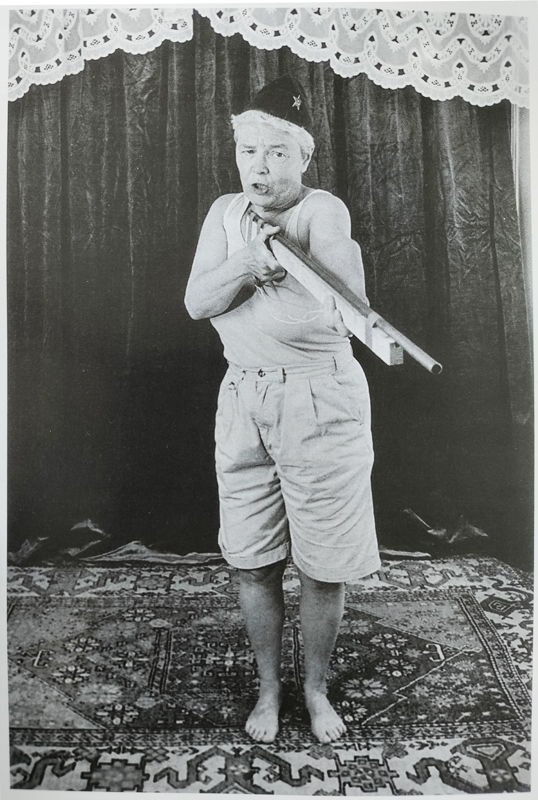
Photo by Ditte Wessels, from the catalogue of Lesbian ConeXion/s, 1998.
Marian Bakker (1944)
a Dutch photographer who came out in the 1980s and divorced her husband. She moved to Amsterdam with her son. There she became an activist. She squatted a building with a number of women. They turned it into a Women’s House. She documented all developments around her with her camera. In 1990, she organized the exhibition ‘De Flanerende Blik’ together with Eef Keijzer at the Melkweg in Amsterdam. The show featured works by nineteen lesbian artists. One of them was Ditte Wessels who became her lifelong partner. Marian Bakker co-organised the photography exhibition Lesbian ConeXion (1989) with German author Traude Bührmann. Today, Marian and Ditte live in Arnhem, Netherlands.
Rosy Martin
based in London, UK created a phototherapy method with Jo Spence. In 1986 she writes: ‘Jo Spence and I have been working cooperatively together, since March 1984, evolving a new photographic practice – phototherapy. Phototherapy is photographing feelings, in all their rawness. It is a means of shifting the understanding of concepts from the cerebral to the gut. By making images of my feelings of inadequacy, gaucheness, and exclusion as an adolescent, working with Jo, I have been able to integrate my intellectual knowledge at a deeper unconscious level. The work decodes sexuality and gendering and begins to show them as social constructs.’
Groundbreaking LGBT group exhibitions in London
LGBT artists presented the zeitgeist and the new gay/lesbian visual language in England:
1987 The Photographers’ Gallery, London collaborated with the quarterly magazine Ten.8 on an exhibition entitled The Body Politic. Artists and photographers in the exhibition included Emily Anderson, Diana Blok, Helen Chadwick, John Coplans, Roberta Graham, Sunil Gupta, Barbara Kruger, David Roberts, Hiro Sato and Jo Spence.
1988 Against the Clause, group exhibition organised by Community Copyart. Including work by Cath Booth, Jackie Burke, Allan deSouza, Sunil Gupta, Mumtaz Karimjee, Keith Khan, Louise Trewavas. An exhibition catalogue was produced with essays by Pratibha Parmar and Zahid Dar, and poetry from Shabnam Grewal.
1988 The Outlook: Two weeks of visual arts against Section 28, Diorama Gallery, London, 24 May-7 June 1988. The exhibition was organised by: Red Wedge and the Organisation of Lesbian and Gay Activists (OLGA). Exhibitors included: Caroline Burgess, Marilyn Collins, Jean Fraser, Roxane Permar, Rosy Martin and Jo Spence.
1988 Against All the Odds – Lesbians & Gays Exhibit, Brixton Art Gallery, London, 21 June – 12 July 1988. Artists: Amanda Owen, Anne Farnan, Anne Robinson, Bol Marjoram, Carl Johnson, Caroline Sheldon, Carolyn Murray, David Sommerville, Dorothy Blackaby, Gary Paul Smith, George Tobias, Gordon Rainford, Harriet Wistrich, Helena Goldwater, Jean Downey, Jimmy Cronin, Jo Spence, John Baldwin, Jola Scicinska, Julia Carellos, Kate Novaczek, Martine Thoquenne, Matthew Grimsdale, Maureen Oliver, Miriam Ludbrook, Paolo Bozzoni, Paul Auber, Penny Baker, Rosy Martin, Rotimi Fani-Kayode, Samadhista, Sandra Lahire, Sarah Bennett, Sef Townsend, Steve Rush, Vanda Carter, Yvette Simpson, Zuni Luni.
1991–1992 Stolen Glances: Lesbians Take Photographs, curated by Tessa Boffin and Jean Fraser, Stills Gallery, Edinburgh; The Cambridge Darkroom; The Pavilion Gallery in Leeds; Darlington Arts Centre; Darlington Arts Centre; Metro Cinema in Darby; Kelvington Art Gallery in Glasgow; Open Eye Gallery in Liverpool; and Camerawork in London. Artists: Tessa Boffin, Deborah Bright, Jacqui Duckworth, Jean Fraser, Della Grace (now Del Grace Volcano), Mumtaz Karimjee, Nina Levitt, Lynette Molnar and Linda Thornburg, Ingrid Pollard, Jill Posener. A book was published with the same title as the exhibition.
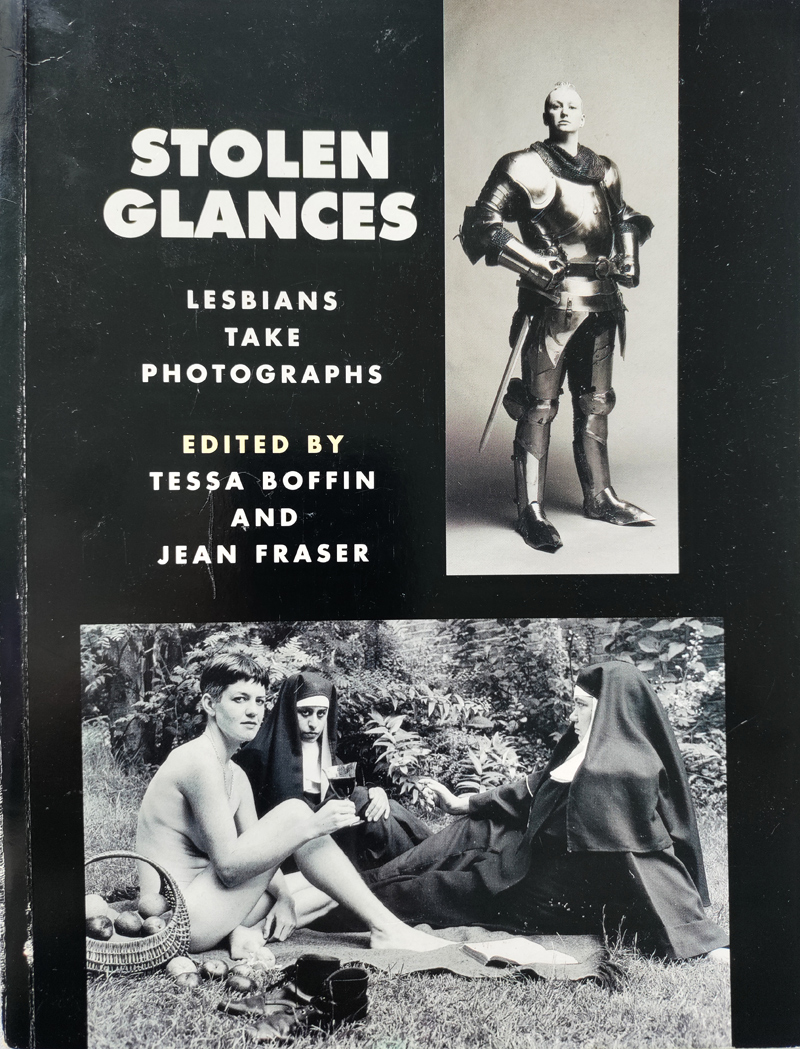
The book cover of Stolen Glances: Lesbians Take Photography with photos by the editors Tessa Boffin (top right) and Jean Fraser (bottom of the cover).
Tessa Boffin (1960-1993)
was a pioneering artist and a key organising figure in the UK’s photography scene, working between the mid-1980s to the early 1990s. Tessa had a BA (Hons) Degree in Photographic Arts and MA in Critical Theory. Despite a brief oeuvre, she developed a complex body of photographic work that explored gender, sex positivity and societal and political issues referring to AIDS. In the staged scenes of her photos, she championed lesbian visibility and the actualization of queer identity through explorations of fantasy. In 1990s, she co-curated the seminal exhibition, Ecstatic Antibodies: Resisting the AIDS mythology (1991) with Sunil Gupta and the major touring exhibition Stolen Glances: Lesbians Take Photographs in 1991 with Jean Fraser.
Lesbian Network Show
In 1992, The London-based Lesbian Network Show was the first specifically lesbian art show in the UK. However, the show is forgotten. There is no mention of it on the Internet.
The Rebel Dykes
originated in the 1980s in London as a group that merged outsider cultures to create fresh feminist explorations of art, sex and activism! A lesbian subculture grew up around the squats in London. Vauxhall in the southwest of London became home to Chain Reaction – the world’s first known lesbian S&M club. The Rebel Dykes Art & Archive Show (2021) brought the Rebel Dyke artists back together for the first time in almost 40 years and united important underrepresented cultural histories with contemporary dyke culture; inviting a variety of younger artists to exhibit new works alongside the dykes who paved their way. The original dyke artists were among others: Del La Grace Volcano, Jessica Tanzer, Maxine Hall, Jamie Lynne Griffiths, Laney Shimmin.
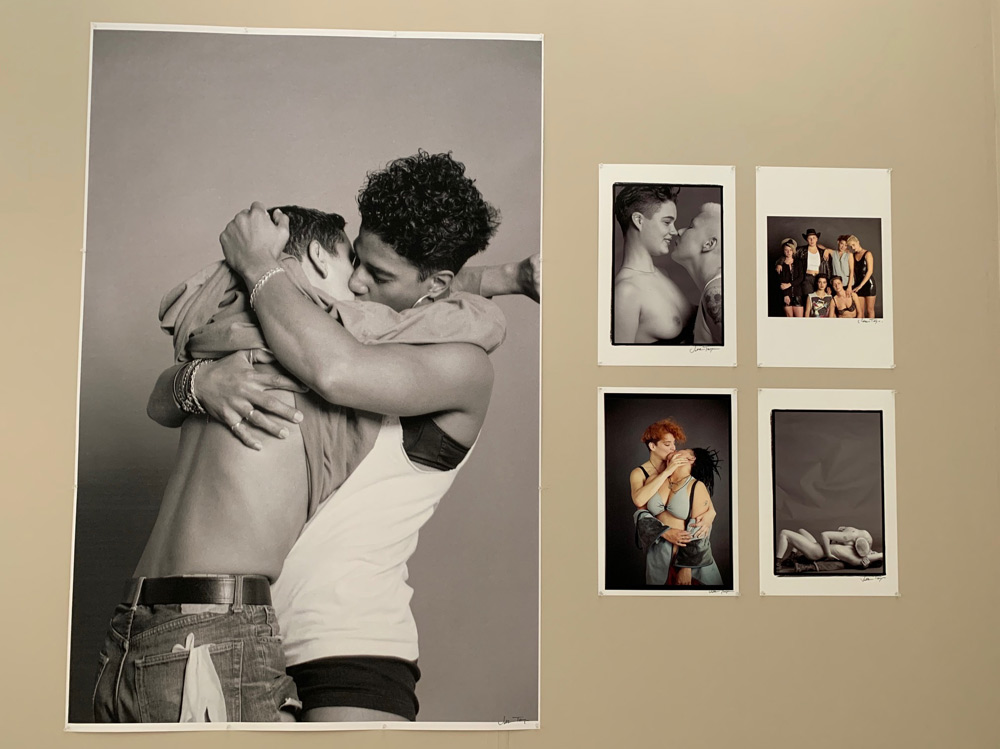
Archive images by Jessica Tanzer. Photo from The Rebel Dykes Art & Archive Show (2021), courtesy of Atalanta Kernick.
Rebel Dykes, a film by Harri Shanahan and Sian A Williams (2021), tells the story of the collective of queer women who founded the legendary South London club and created a community around it. “I wanted to make the film because I’ve always felt a connection to the ethos of the Rebel Dykes,” co-director Sian A Williams says, “Their art and music was a formative influence when I was playing in post-punk bands, and I was especially excited by the Rebel Dyke photographers that play with gender and identity and documented queer communities, all of which inspired my own visual art practice at the time.”
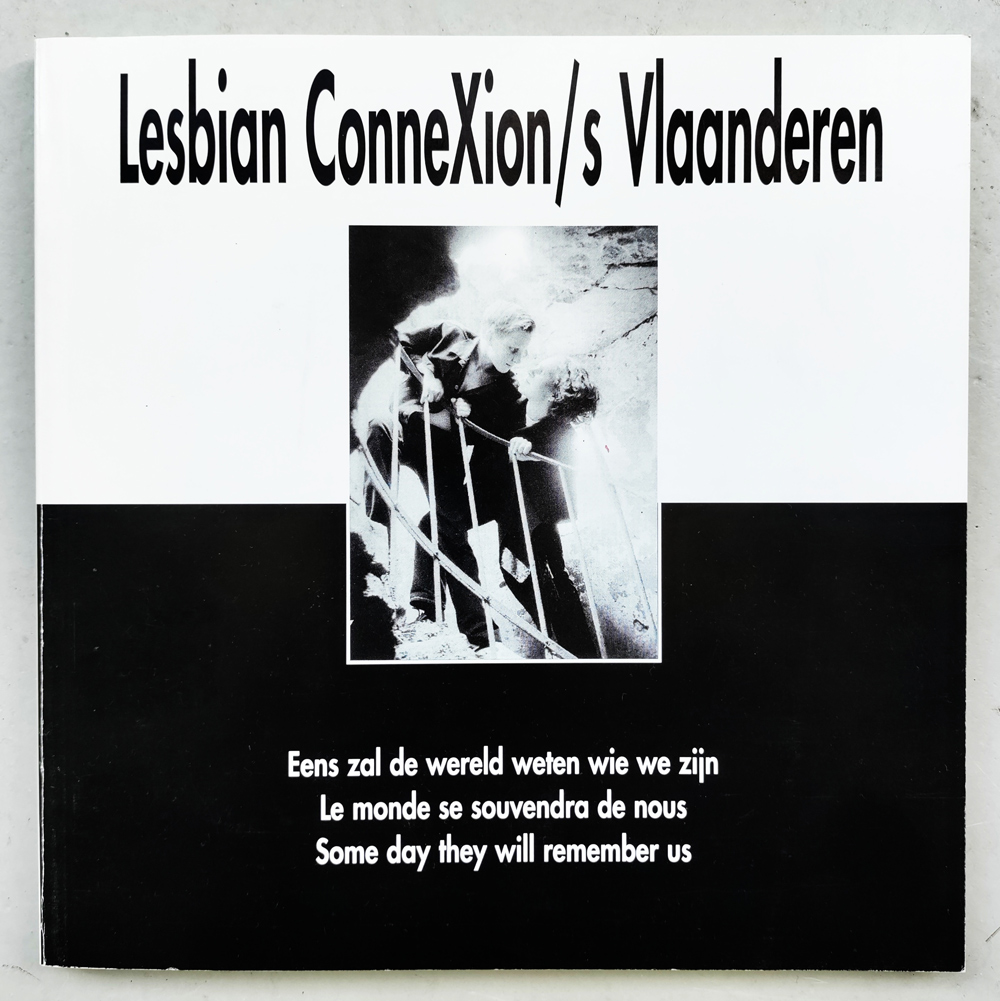
The cover of the catalogue, Lesbian ConeXion/s.
Lesbian ConeXion/s, (1998)
was a large touring photography exhibition that featured works by 63 lesbian artists from 14 European countries. It opened in Amsterdam, Holland in 1998. Then the exhibition tour went to Ljubljana, Zagreb, Beograd, Sankt Petersburg and San Francisco. The Dutch artist duo Ditte Wessels and Marian Bakker gave photography and lesbian identity workshops alongside the different iterations of the exhibition.
Queer feminist artists in the 1990s
The mid-career queer feminist artists today (2023) started their careers in the 1990s. Looking back at their works we are likely to see them as a part of the emerging queer art movement in Europe. Were their works from the 1990s confrontational? Not always, as queer feminist art is so much more than confrontational statements. The queer (feminist) art movement in Europe is diverse. There are many amazing queer women artists whose early works can be embraced and taken into the queer and queer feminist debate of the mainstream art world today. This is but a few of them. You may already know their names:
Martina Minette Dreier (Germany) painted her Cityscapes in the early 1990s; the paintings were triptychs of monochrome facades and blank walls in East Berlin. Today, she is known for her portrait paintings of queer performers.
Veronica Slater (UK). Alongside her own creative practice that started in the late 1980s, Veronica has taught Fine Art at various university colleges internationally and in the UK. She lives and works in Brighton UK. Her works were featured in Cherry Smyth’s book Dammed Fine Art – by New Lesbian Artists (1996).
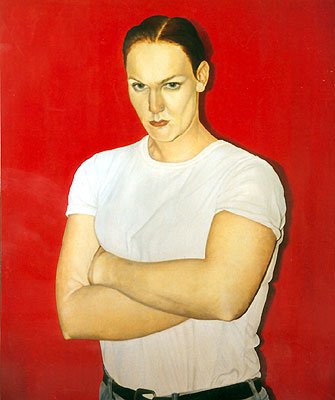
Raging Bull, (1993) oil on canvas by Sadie Lee.
Sadie Lee (UK) painted her series Tomboys and Crossdressers (1991-1996) and Ladies of the Burlesque (1996-1997). Her works were also featured in Cherry Smyth’s book Dammed Fine Art – by New Lesbian Artists (1996).
Brigitta Hosea (UK), a visual artist, educator and animation artist. She explores themes such as identity, spirituality and traces of existence. Her sculptural chairs from the early 1990s were overtly erotic. Her works were featured in Cherry Smyth’s book Dammed Fine Art – by New Lesbian Artists (1996).
Cabello/Carceller, a Spanish queer feminist artist duo. They started their collaboration in 1993. Their website reads that they have developed ’an interdisciplinary work that uses different media – installation, performance, video, writing, drawing – to examine the hegemonic means of representation in visual practices, suggesting critical alternatives to them. From a conceptual, politically engaged approach, they use strategies as appropriation or performance and fiction to question the modernist narratives that avoid minority politics while recurrently quoting them.’
Ingrid Pollard, a British artist and photographer. Her work uses portrait photography and landscape imagery to explore social constructs such as Britishness or racial difference and colonialism, exploring the presence of black people in the English landscape. Ingrid’s works are featured in Stolen Glances, edited by Tessa Boffin and Jean Fraser (1991), and in Cherry Smyth’s book Dammed Fine Art – by New Lesbian Artists (1996).
Lill-Ann Chepstow-Lusty, (UK) is a visual artist based in Oslo, Norway. She is known for having explored many different themes such as nationalism, sexuality and homosexuality, Norwegian cowboys, modern Vikings, gay children, transvestites, identity and society. Her images are often staged and are satirical or humorous. She had her first solo show in Norway in 1984.
Related Links
Article: Lesbian Art History in Europe 1850 – 1950 by Birthe Havmøller
Article: Queer Art: 1960s to the Present by the American site arthistoryteachingresources.org